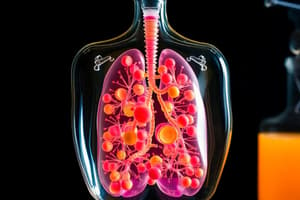Podcast
Questions and Answers
Cellular respiration is generally associated with the ______.
Cellular respiration is generally associated with the ______.
cytoplasmic membrane
What is the final electron acceptor in anaerobic respiration?
What is the final electron acceptor in anaerobic respiration?
- Oxygen
- Organic compounds
- Inorganic compounds other than oxygen (correct)
- Carbon dioxide
What is the difference between aerobic respiration and anaerobic respiration?
What is the difference between aerobic respiration and anaerobic respiration?
The main difference lies in the final electron acceptor. Aerobic respiration uses oxygen, while anaerobic respiration uses inorganic compounds other than oxygen.
The electron transport chain in anaerobic respiration is identical to aerobic respiration.
The electron transport chain in anaerobic respiration is identical to aerobic respiration.
Which of the following are examples of electron acceptors used in anaerobic respiration?
Which of the following are examples of electron acceptors used in anaerobic respiration?
What bacteria can grow anaerobically when glucose is oxidized using nitrate as the final electron acceptor?
What bacteria can grow anaerobically when glucose is oxidized using nitrate as the final electron acceptor?
Anaerobic respiration does not produce nitrogen gas.
Anaerobic respiration does not produce nitrogen gas.
Desulfovibrio sulfuricans bacteria are a type of bacteria that reduce ______ to sulfide ions.
Desulfovibrio sulfuricans bacteria are a type of bacteria that reduce ______ to sulfide ions.
What is the chemical formula for sulfide ions?
What is the chemical formula for sulfide ions?
What environmental process is responsible for the blackening of mud, often observed in areas like the Black Sea?
What environmental process is responsible for the blackening of mud, often observed in areas like the Black Sea?
Fermentation is another ______ pathway for breaking down glucose.
Fermentation is another ______ pathway for breaking down glucose.
What is the primary reason why microbes utilize fermentation rather than aerobic respiration under anaerobic conditions?
What is the primary reason why microbes utilize fermentation rather than aerobic respiration under anaerobic conditions?
In fermentation, pyruvate is utilized in the citric acid cycle.
In fermentation, pyruvate is utilized in the citric acid cycle.
Why is pyruvate important in fermentation?
Why is pyruvate important in fermentation?
Lactic acid fermentation, a type of fermentation, is often associated with the production of ______.
Lactic acid fermentation, a type of fermentation, is often associated with the production of ______.
Alcohol fermentation produces lactic acid as a byproduct.
Alcohol fermentation produces lactic acid as a byproduct.
What is the name of the molecule produced by the removal of the carboxyl group from pyruvate?
What is the name of the molecule produced by the removal of the carboxyl group from pyruvate?
Acetaldehyde is reduced to ______ in the presence of NADH.
Acetaldehyde is reduced to ______ in the presence of NADH.
Heterolactic lactic fermentation produces only lactic acid.
Heterolactic lactic fermentation produces only lactic acid.
What type of bacteria is primarily responsible for butyric fermentation?
What type of bacteria is primarily responsible for butyric fermentation?
Which of the following is a characteristic of propionic fermentation?
Which of the following is a characteristic of propionic fermentation?
Butanediol fermentation is an aerobic fermentation.
Butanediol fermentation is an aerobic fermentation.
What is the primary end product of butanediol fermentation?
What is the primary end product of butanediol fermentation?
The catabolic pathways for monosaccharides, like glucose, fructose, mannose, and galactose, involve ______ to glucose or its derivatives.
The catabolic pathways for monosaccharides, like glucose, fructose, mannose, and galactose, involve ______ to glucose or its derivatives.
Fructose, mannose, and galactose are directly utilized in glycolysis without any prior modification.
Fructose, mannose, and galactose are directly utilized in glycolysis without any prior modification.
What is the specific process that galactose undergoes before entering the Embden-Meyerhof pathway?
What is the specific process that galactose undergoes before entering the Embden-Meyerhof pathway?
Disaccharides are always cleaved by hydrolysis.
Disaccharides are always cleaved by hydrolysis.
Which of the following disaccharides is NOT directly hydrolyzed to its constituent sugars?
Which of the following disaccharides is NOT directly hydrolyzed to its constituent sugars?
What is the name of the enzyme that hydrolyzes maltose to glucose?
What is the name of the enzyme that hydrolyzes maltose to glucose?
Maltose phosphorylase breaks down maltose into B-D-glucose-1-P and ______.
Maltose phosphorylase breaks down maltose into B-D-glucose-1-P and ______.
Polysaccharides are cleaved exclusively by phosphorolysis.
Polysaccharides are cleaved exclusively by phosphorolysis.
How do prokaryotes and fungi degrade external polysaccharides?
How do prokaryotes and fungi degrade external polysaccharides?
Starch and glycogen are hydrolyzed by ______ to glucose, maltose, and other products.
Starch and glycogen are hydrolyzed by ______ to glucose, maltose, and other products.
Cellulose is easily hydrolyzed by most organisms.
Cellulose is easily hydrolyzed by most organisms.
What is pectin and how is it degraded?
What is pectin and how is it degraded?
Certain fungi can degrade lignin by releasing ______ enzymes.
Certain fungi can degrade lignin by releasing ______ enzymes.
Agar is degraded by an enzyme called agarase.
Agar is degraded by an enzyme called agarase.
Which of the following is NOT a reserve polymer commonly catabolized by microorganisms?
Which of the following is NOT a reserve polymer commonly catabolized by microorganisms?
How are glycogen and starch degraded?
How are glycogen and starch degraded?
Azotobacter, a soil bacterium, hydrolyzes PHB to 3-hydroxybutyrate, and subsequently oxidizes it to ______.
Azotobacter, a soil bacterium, hydrolyzes PHB to 3-hydroxybutyrate, and subsequently oxidizes it to ______.
Flashcards
Anaerobic respiration
Anaerobic respiration
A type of cellular respiration that does not require oxygen.
Fermentation
Fermentation
An anaerobic process that breaks down carbohydrates.
Catabolism
Catabolism
Breaking down complex molecules into simpler ones.
Carbohydrates
Carbohydrates
Signup and view all the flashcards
Glucose
Glucose
Signup and view all the flashcards
Respiration
Respiration
Signup and view all the flashcards
Cellular respiration
Cellular respiration
Signup and view all the flashcards
Other than glucose
Other than glucose
Signup and view all the flashcards
Non-glucose carbohydrates
Non-glucose carbohydrates
Signup and view all the flashcards
Aerobic Respiration
Aerobic Respiration
Signup and view all the flashcards
Study Notes
Anaerobic Respiration
- Cellular respiration is usually linked to the cytoplasmic membrane
- In anaerobic respiration, inorganic compounds act as the final electron acceptors, instead of oxygen.
- The electron transport chain is similar to aerobic respiration, but with a different final electron acceptor.
- Nitrate (NO₃⁻) and sulfate (SO₄²⁻) are common electron acceptors in anaerobic respiration.
- E. coli bacteria can use nitrate as the final electron acceptor during anaerobic glucose oxidation, producing nitrate derivatives (NO₂⁻) and nitrogen gas (N₂).
- Desulfovibrio sulfuricans bacteria reduce sulfate (SO₄²⁻) to sulfide ions (S²⁻) in the form of hydrogen sulfide (H₂S) or atomic sulfur (S), which is responsible for the blackening of mud, including the Black Sea.
Fermentation
- Fermentation is an anaerobic process for glucose breakdown in various microorganisms.
- Microorganisms lacking or repressing electron transport chain components perform fermentation.
- In fermentation, pyruvate (from glycolysis) bypasses the citric acid cycle and the electron transport chain.
- Microbes use pyruvate or its derivatives to re-oxidize NADH (a product of glycolysis.)
- There are multiple types of fermentation pathways for sugar breakdown.
Specific Types of Fermentation
Lactic Acid Fermentation
- Occurs in some Bacillus and Lactobacillus species.
- This leads to cheese production.
- In lactic acid fermentation, NADH directly transfers electrons to pyruvate creating lactate as a byproduct.
- The process converts glucose to lactic acid, and involves the transfer of electrons from NADH to pyruvate, producing lactate.
Alcohol Fermentation
- Performed by yeast and selected bacteria.
- Pyruvate from glucose metabolism is converted into ethanol and carbon dioxide.
- NADH donates electrons in a two-step process.
- Step one: removing the carboxyl group from pyruvate releases carbon dioxide, making a two-carbon molecule called acetaldehyde.
- Step two: acetaldehyde is reduced to ethanol using NADH.
Heterolactic Fermentation
- Produces ethanol, acetic acid, carbon dioxide and glycerol besides lactic acid under anaerobic conditions.
Butyric Fermentation
- Clostridium bacteria, including C. butyricum, participate in this.
- The end products are carbon dioxide, butyrate and gas (acid).
Propionic Fermentation
- It involves the production of propionic acid, carbon dioxide and acetic acid by Propionibacterium.
Butanediol Fermentation
- Using 2,3-butanediol as a terminal electron acceptor.
- It can also produce ethanol, lactic acid and formic acid.
- This fermentation type is tested using the Voges-Proskauer test.
Catabolism of Carbohydrates other than Glucose
Monosaccharides
- Glucose, fructose, mannose and galactose are converted into glucose or its derivates.
- First three are phosphorylated using ATP and easily enter the Embden-Meyerhof pathway.
- Galactose requires conversion to UDP-galactose then glucose-6-phosphate before entering glycolysis.
Disaccharides
- Common Disaccharides like maltose, sucrose, and lactose break down to monosaccharides.
- Hydrolysis: These disaccharides can be directly hydrolyzed to constituent monosaccharides by the respective enzymes.
- Phosphorolysis: Maltose, cellobiose, and sucrose are cleaved by a phosphate attack on the bond between sugar monomers.
Polysaccharides
- Polysaccharides are broken down into smaller molecules usable by prokaryotes or fungi by enzymes.
- Starch and glycogen are hydrolyzed by amylases to monosaccharides, such as glucose, maltose, and others.
- Cellulose is digested by cellulases from some fungi into cellobiose and glucose.
- Pectin and lignin are degraded by soil bacteria, fungi.
- Agar breakdown is performed by certain actinomycetes and Cytophaga through an enzyme called agarase.
Reserve Polymers
- Glycogen and starch are degraded by phosphorolysis, forming glucose-1-phosphate, which enters glycolysis.
- Poly-β-hydroxybutyrate (PHB) is hydrolyzed to 3-hydroxybutyrate by the soil bacterium Azotobacter which is then oxidized to acetoacetate.
Studying That Suits You
Use AI to generate personalized quizzes and flashcards to suit your learning preferences.
Related Documents
Description
This quiz covers the processes of anaerobic respiration and fermentation, highlighting the role of different electron acceptors like nitrate and sulfate. It discusses the mechanisms in bacteria such as E. coli and Desulfovibrio sulfuricans. Test your knowledge on how microorganisms metabolize glucose without oxygen.




